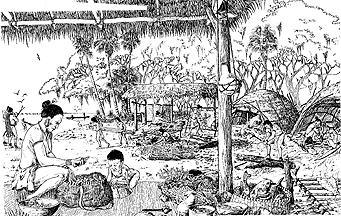Yat Kitischee – Life in a Coastal Hamlet
As the day begins the men load their nets into dugouts and get ready to fish the tide change. The evening before they had heard the mullet jumping between the oyster beds and mangroves. They push off and paddle in that direction. Meanwhile, women stoke the fires which burned low overnight and place clumps of leaves onto the flames to help chase away the mosquitoes. A group of three hunters who spent the previous evening knapping arrowheads with antler hammers decide to scout out a fresh game trail not very far inland. They quietly disappear into the pine and palmetto with their arrows notched, but not yet drawn.
With most of the men gone, a group of women and their children leave the village to collect oysters from a nearby bed. Whelk shell beads sway against their chests as they walk carefully over the sharp oyster shells. Once their baskets are full, they return to the village where they remove the meat from the shells and dump it into a stew pot suspended over an open fire. Some unopened shells spill into the coals and are left to roast. Chunks of shark meat and catfish are already simmering in the soup which several families will share.
A few of the villagers have their hair pulled back and held in place with finely carved bone pins. Taking advantage of the cool morning, children comb the nearby woods for firewood, while others collect palmetto berries, blackberries, blueberries, mulberries, and prickly pear cactus fruit. Upon their return, mothers notice their children’s blue-stained lips and half-full baskets. But not everyone is busy fishing and hunting and gathering.
Nets from yesterday’s fishing are being mended with bone shuttles and palmetto fiber cordage. Stacks of fresh green palmetto fronds sit next to the huts being repaired after a recent storm. An old fisherman is shaping a dugout canoe with a shell adze. Women clean up from last night’s feast and dump the oyster shell, fish bone, animal bone, and a broken pot onto the garbage pile downwind of the village. Raccoon tracks lead from the pile into the mangroves. From atop the garbage pile the women can see the fishermen hauling in full nets. The water behind their dugouts is white and choppy with mullet, trout, redfish, and catfish. Seagulls and pelicans circle overhead and dive for their catch.
On the way back to the village the women walk past a large deer hide stretched between the posts of a tanning rack, past a potter pulling a new vessel from the coals, and past filets of redfish and stingray drooping over a smoking stand. They stop and sample a piece of moist redfish. Another day at Yat Kitischee is under way.

The scene described above is a fictional reconstruction of prehistoric life on Tampa Bay circa a.d. 800. It is based on archaeological evidence recovered during two seasons of excavation at Yat Kitischee, a prehistoric hamlet in Pinellas County, Florida. This booklet describes how the site was discovered, how state and local governments, archaeologists, and Native Americans worked together to ensure it’s protection, and how the public became involved in a unique educational experience. It also explains what modern archaeology is all about, how it is done, and why. By using the Yat Kitischee Project as an example, we hope to convey some of the excitement that comes from carefully uncovering and learning about the past from the everyday items that people lose, throw away, or leave behind when they depart.